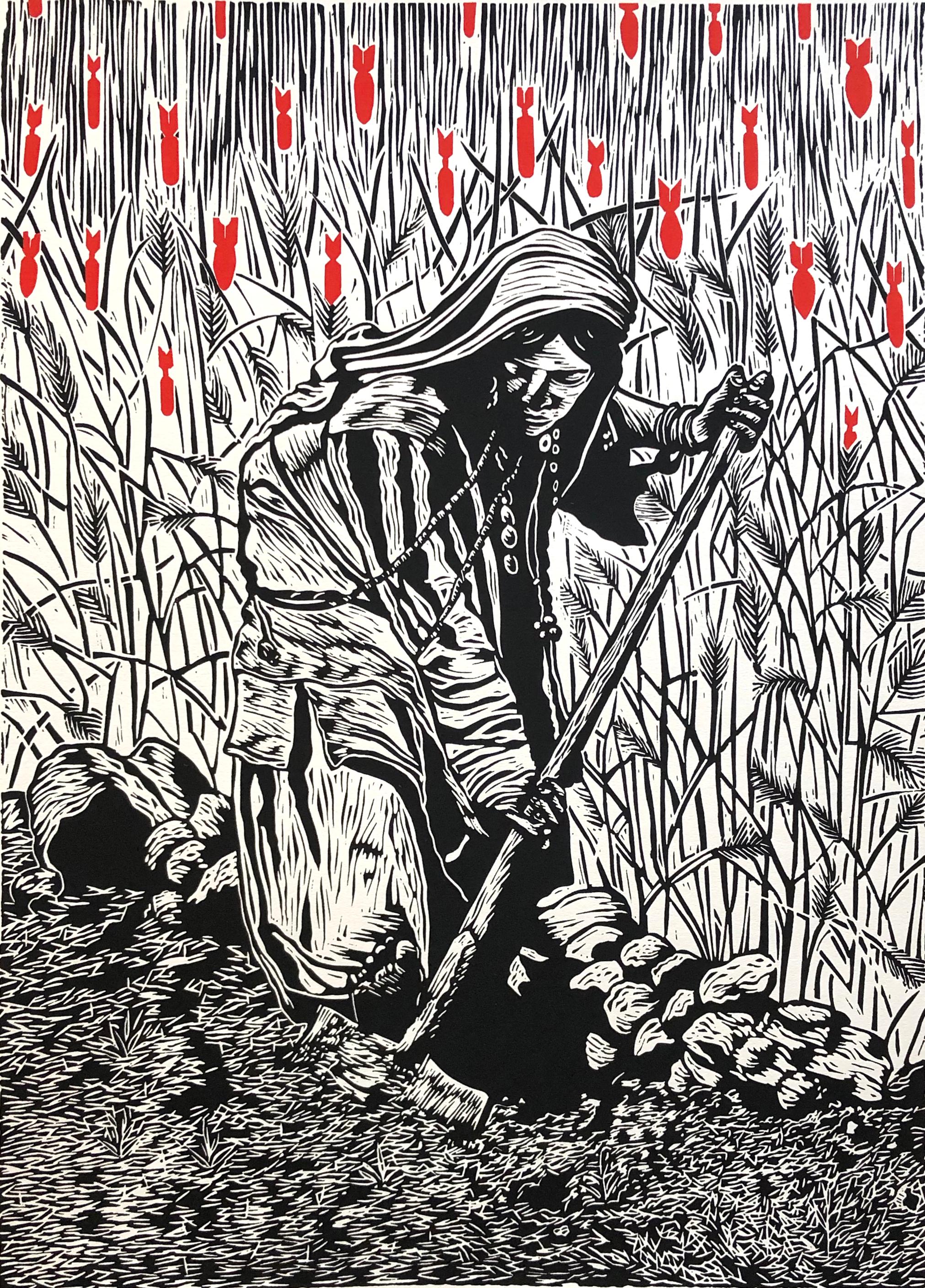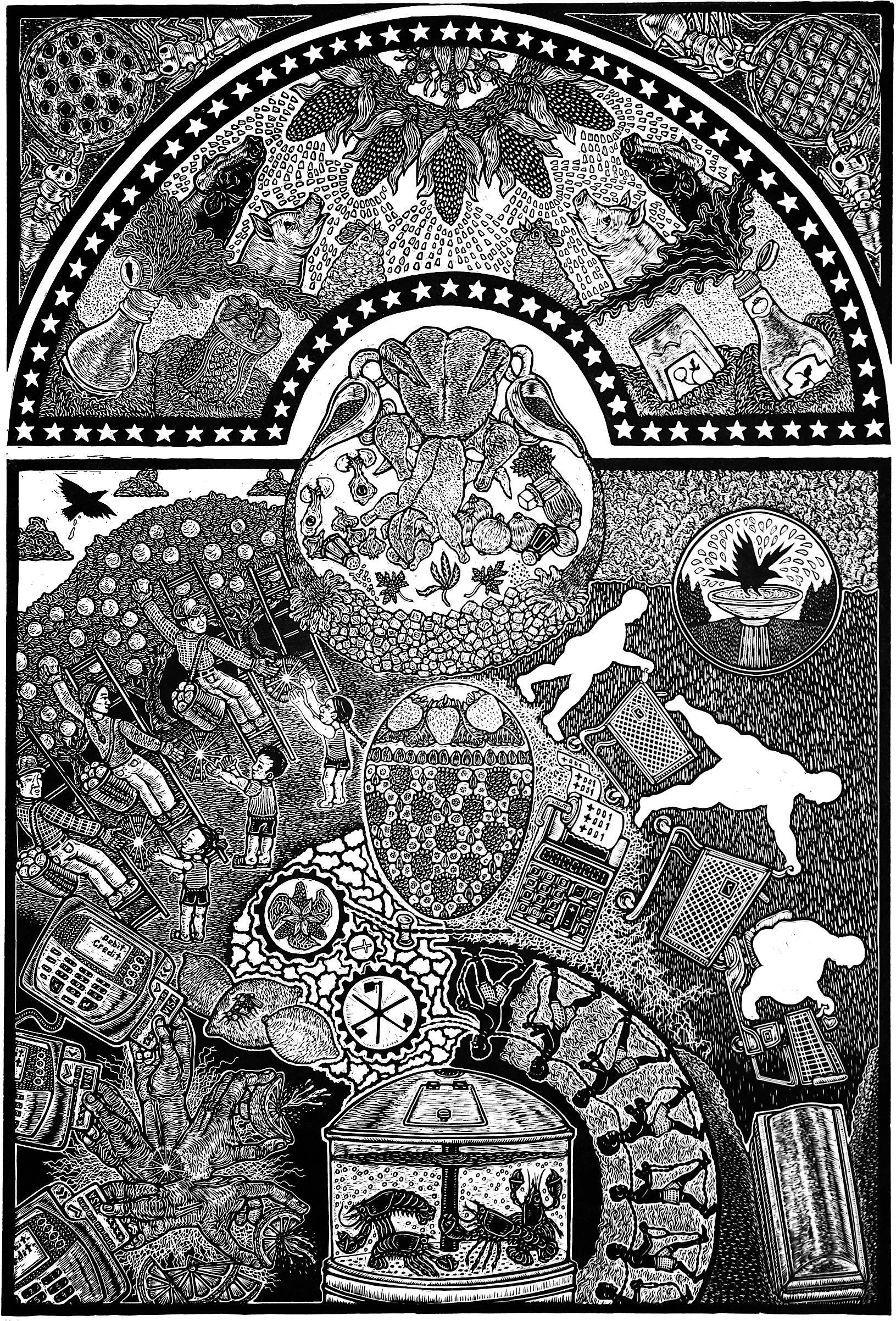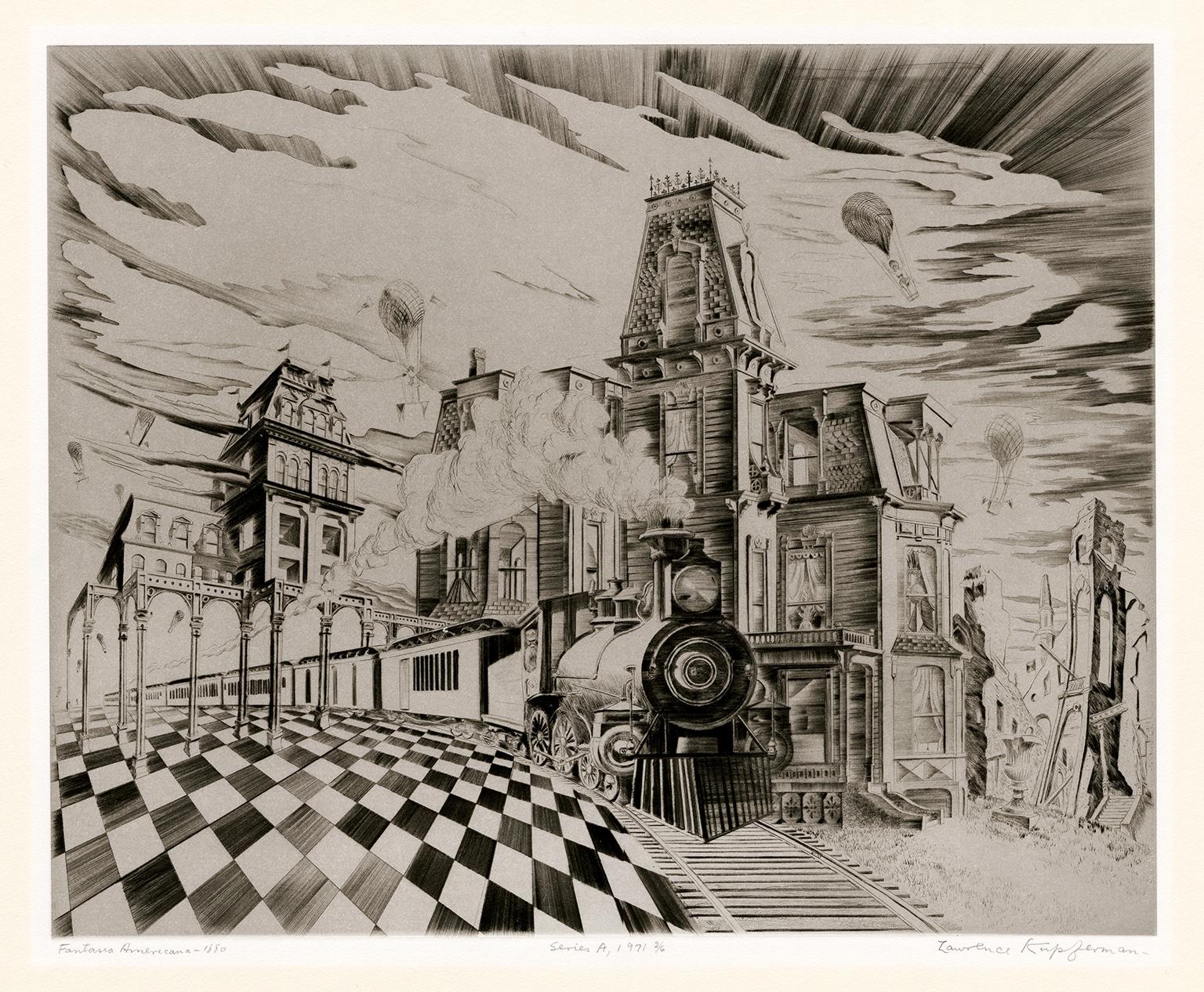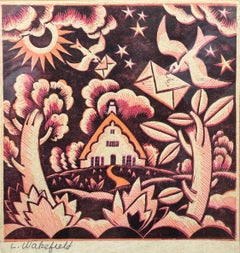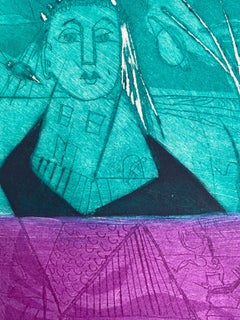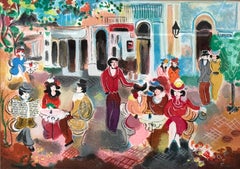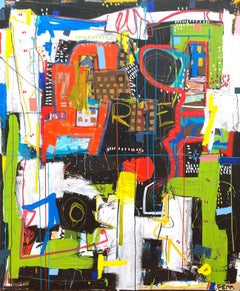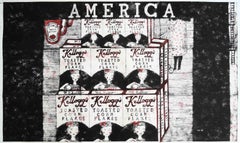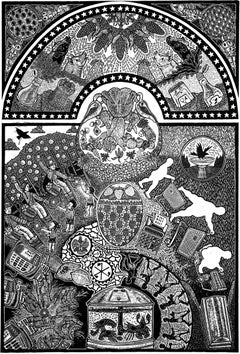Want more images or videos?
Request additional images or videos from the seller
1 of 9
Ralph Fabri“Americana”1947
1947
$675
$97530% Off
£525.52
£759.0830% Off
€597.60
€863.2030% Off
CA$970.46
CA$1,401.7730% Off
A$1,065.75
A$1,539.4230% Off
CHF 556.56
CHF 803.9130% Off
MX$12,720.18
MX$18,373.6030% Off
NOK 7,051.02
NOK 10,184.8130% Off
SEK 6,571.83
SEK 9,492.6430% Off
DKK 4,463.30
DKK 6,44730% Off
About the Item
Here for your consideration is a wonderful original etching on archival paper by the well known American artist, Ralph Fabri. Strong impression; signed in pencil by the artist lower right margin. Titled and dated bottom left of the sheet “1947-Americana”. Condition of the etching is excellent. Top corner of sheet and bottom right corner of sheet have tiny creases. Not visible, under the mat. Sheet size is 12 by 15 inches. Image size is 8 by 9.75 inches. Matted but not framed. Provenance: A Long Island, New York collector.
Painter and printmaker, commercial artist, writer, and teacher, Ralph Fabri was born Fabri Reszo in Hungary in 1894. He was educated in Budapest, first studying architecture at the Royal Institute of Technology from 1912 to 1914. He then enrolled in the Royal Academy of Fine Arts, from which he graduated in 1918 with a Professor's Diploma (M.A.) "for teaching drawing, painting and geometry – including descriptive and projective geometry – in schools of higher education."
Fabri arrived in New York City in 1921 and soon adopted the anglicized version of his name, Ralph Fabri. He began doing commercial design work and during the academic year of 1923/24 was enrolled as an evening student at the National Academy of Design. After becoming an American citizen in 1927, he traveled extensively in Europe. Upon returning to New York that same year, Fabri decided his financial situation was stable enough to allow him to focus his attention on fine art.
During the Great Depression, Fabri's already inadequate portrait commissions and art sales further declined and he returned to commercial work. He established a workshop known as the Ralph Fabri Studios, that designed theatrical and movie sets, window displays, and retail interiors. But Fabri found the workshop dirty and distasteful, and eventually was able to concentrate on advertising work which could be done from home. The largest clients for his pen and ink drawings were The Stamp and Album Co. of America, Inc. (for which he designed covers for stamp albums and produced illustrations for envelopes housing sets of stamps sold to collectors), Geographica Map Co., and Joseph H. Cohen & Sons (for whom he designed and illustrated mail order catalogs). Another source of income during this period was the design and construction of an addition to "Iroki," Theodore Dreiser's estate in Mt. Kisco, N.Y., for which Fabri acted as architect and contractor.
Soon after arriving in the United States, Fabri began writing art reviews and articles on art and other topics for publication in Hungarian newspapers, and began submitting similar pieces to American newspapers and periodicals. Between 1949 and 1951 Pictures on Exhibit published a series of twenty articles by Fabri on materials and techniques, and from 1952 through 1961 he was a critic for that publication. Fabri contributed many articles on a variety of topics to Today's Art, starting in 1953, the year the magazine was established. In 1961, Fabri became associate editor of that monthly periodical and was named its editor in 1970, a position he held for the remainder of his life. During his tenure, every issue of Today's Art included signed and unsigned articles and editorials by Fabri, as well as some pieces written under pseudonyms. He also worked as a book reviewer for American Artist and art editor of Funk & Wagnall's New Encyclopedia .
Fabri may be best known for his books in the how-to-do-it vein, some of which were distributed through art supply stores. Among his many books are: Learn to Draw (1945), Oil Painting: How-to-Do-It! (1953), A Guide to Polymer Painting (1966), Sculpture in Paper (1966), Color: A Complete Guide for Artists (1967), Complete Guide to Flower Painting (1968), The First Hundred Years: History of the American Watercolor Society (1969), Painting Outdoors (1969), Painting Cityscapes (1970), and Artist's Guide to Composition (1971).
For nearly three decades, Fabri taught art in New York City. He was an instructor in the life and still life classes at the Parson's School of Design from 1947 through 1949. In 1951, Fabri was appointed associate professor at City College of New York, where he taught painting and art history until retiring in 1967. In addition, he was on the faculty of School of the National Academy of Design, teaching painting, drawing, and graphics from 1964 until his death.
Fabri was an active member of many artists' organizations. He was president of the National Society of Painters in Casein, Inc., an organization founded by Fabri in 1953 (it later became the National Society of Painters in Casein and Acrylic, Inc.); he also served as president of the Audubon Artists and the Allied Artists of America, Inc. As historian of The American Watercolor Society, Fabri wrote a book length history of that organization published on the occasion of its centennial. He was the secretary and treasurer of the National Academy of Design, as well as serving on many of its committees.
Paintings and prints by Ralph Fabri have been exhibited widely in solo and group exhibitions throughout the United States and, to a lesser extent, in Europe. A frequent lecturer, his painting demonstrations were quite popular. Fabri received numerous honors and awards, and his work is included in the permanent collections of the Metropolitan Museum of Art, the Library of Congress, the New York Public Library, the National Academy of Design, the Norfolk Museum of Art and Science, Smithsonian Institution, the Museum of Fine Arts, the National Gallery in Budapest, and many other public and private collections.
Ralph Fabri died in New York City in February 1975.
- Creator:Ralph Fabri (1894 - 1975, American)
- Creation Year:1947
- Dimensions:Height: 8 in (20.32 cm)Width: 9.75 in (24.77 cm)Depth: 0.25 in (6.35 mm)
- Medium:
- Movement & Style:
- Period:
- Condition:
- Gallery Location:Southampton, NY
- Reference Number:1stDibs: LU14110354402
About the Seller
5.0
Platinum Seller
Premium sellers with a 4.7+ rating and 24-hour response times
Established in 1977
1stDibs seller since 2013
552 sales on 1stDibs
Typical response time: <1 hour
- ShippingRetrieving quote...Shipping from: Sarasota, FL
- Return Policy
More From This Seller
View All“Untitled”
Located in Southampton, NY
Original multicolor linocut by the American artist, Lucina Smith Wakefield. Signed by the artist lower left margin. Circa 1930. Condition is very good, no issues. The linocut is hou...
Category
1930s American Modern Landscape Prints
Materials
Archival Paper, Linocut
$380 Sale Price
20% Off
“Untitled”
By Nahum Tschacbasov
Located in Southampton, NY
Hand colored original artist proof etching by the well known Russian/American artist Nahum Tschacbasov. Marked “AP” lower left for artist proof in pencil. Signed by the artist lower...
Category
1940s Modern Figurative Prints
Materials
Archival Paper, Etching
$396 Sale Price
20% Off
“La Balesta”
By Zule Moskowitz
Located in Southampton, NY
Original colored lithograph by the Argentina born artist Zule Moskowitz. Signed “Zule” bottom right. Condition is excellent. Circa 2000. Gallery label verso. Under glass. Beautifull...
Category
Early 2000s Contemporary Figurative Prints
Materials
Archival Paper, Lithograph
$600 Sale Price
20% Off
“The Greatest Story Ever Told”
By Joseph Conrad-Ferm
Located in Southampton, NY
Original acrylic on canvas painting by the well known American artist, Joseph Conrad Ferm. Condition is excellent. Signed lower right “Ferm”. Titled, signed and dated verso 2012. Un...
Category
2010s Post-Modern Abstract Paintings
Materials
Canvas, Acrylic
“Untitled”
By Nahum Tschacbasov
Located in Southampton, NY
Early oil on canvas painting by the well known American artist, Nahum Tschacbasov done in the “Social Realism” period of the artist’s career. Signed lower left. Original artist inventory label on stretcher verso dates the painting to 1937. Condition of the painting is very good. The painting is housed in a contemporary version of a House of Heydenryk frame that measures overall 14.25 by 27.25 inches. Provenance: Estate of the artist Nahum Tschacbasov.
Nahum Tschacbasov
Biography :
Russian-American artist Nahum Tschacbasov (1899-1984) is known for his cubo-surrealistic works which feature a strong psychological element. Some of his work bears a resemblance to work of another Russian-American artist--David Burliuk. He was somewhat of a late starter, moving to Paris in 1932 to study under Adolph Gottlieb, Marcel Gromaire and Fernand Leger. He had his first exhibition in Paris in 1934. He then returned to the US where he joined Rothko and Gottlieb at the Galery Seccession. He was one of the co-founders of The Ten, a group of social conscious abstract painters which included Rothko, Gottlieb, Joseph Solman and Ilya Bolotowsky, among others.
In 1944, he began to work at Stanley Hayter's Atelier 17, a center for surrealistic ideas. Between 1936 and 1943, he had five one-man exhibitions at the ACA Galleries and participated in five group shows. He also exhibited at the Whitney, the Pennsylvania Academy of Fine Arts, the Knox Albright Museum, the Chicago Institute of Fine Art and Corcoran, among others. His work can be found in the permanent collections of the Met, the Whitney, the Brooklyn Museum and the Jewish Museum.
Tschacbasov has been the subject of two recent retrospective at Fletcher Gallery, Woodstock, NY and Arthur...
Category
1930s American Modern Figurative Paintings
Materials
Canvas, Oil
"Untitled"
By Nahum Tschacbasov
Located in Southampton, NY
Artist proof, aquatint, mixed intaglio engraving by the Russian/American artist, Nahum Tschacbasov. Pencil signed and dated lower right, 1947. Artist Proof. Condition: good; slight...
Category
1940s Surrealist Figurative Prints
Materials
Engraving, Aquatint, Intaglio
$420 Sale Price
20% Off
You May Also Like
Etchings - "America"
By MAE Curates
Located in Los Angeles, CA
This is a beautiful new etching - a whimsical, imaginative, exquisitely detailed piece.
Other photos illustrate exhibited other works. Inquire.
Framing options available in Los Angeles, London, New York.
The etching is by a Japanese etching...
Category
21st Century and Contemporary Contemporary Figurative Prints
Materials
Etching
Made In America, by Juan Fuentes
By Juan Fuentes
Located in Palm Springs, CA
An Afghan woman laborer working a field of grain, with a backdrop of bombs falling from the sky.
Signed, numbered and titled in pencil, from the edition of 125. As a cultural ac...
Category
Early 2000s Contemporary Figurative Prints
Materials
Screen
American Consumerism I
By Jesse Shaw
Located in Philadelphia, PA
linocut, edition of 15
The artwork is shipped unframed and measures 36in x 24in. Please message us directly if you are interested in custom framing for your print.
Bio // Jesse Sha...
Category
21st Century and Contemporary Contemporary Abstract Prints
Materials
Linocut
American Icon
By Arica Hilton
Located in Chicago, IL
Archival Pigment Print on canvas
Edition size: 10 plus 2 artist proofs
Each canvas is hand painted by the artist
Available in the following sizes:
20" x 40" • 30" x 60" • 36" x 72" • 47" x 96"
“American Icon” examines the world’s perception of America. It combines quintessential American imagery to create a depiction of this nation as seen through the eyes of the world. From the Founding Fathers to Facebook, Cowboys and the Wild West; The Wright Brothers to PanAm; Mickey Mouse to Marilyn Monroe, John Wayne, Frank Sinatra, Elvis; Babe Ruth to Hank Aaron...
Category
21st Century and Contemporary Contemporary Landscape Prints
Materials
Canvas, Mixed Media, Oil
Price Upon Request
Wuxtry! [Extra!]
By Albert Abramovitz
Located in New York, NY
Albert Abramovitz (1879-1963), Wuxtry! [Extra?!], linocut in colors, c. 1936, signed in pencil lower right and titled lower center [also initialed in the plate]. In very good conditi...
Category
1930s American Realist Figurative Prints
Materials
Linocut
'Fantasia Americana, 1880' — Mid-Century American Surrealism
By Lawrence Kupferman
Located in Myrtle Beach, SC
Lawrence Kupferman, 'Fantasia Americana – 1880', drypoint etching with sandground, 1943. Signed, titled, and annotated 'Series A, 1971 2/6' in pencil. A superb, richly-inked impression, on heavy, cream wove paper, with full margins (2 1/2 to 3 1/2 inches); the paper slightly lightened within the original mat opening, otherwise in excellent condition. One of only 6 impressions printed in 1971, with the added sandground grey background tint. Archivally matted to museum standards, unframed.
Image size 11 13/16 x 14 3/4 inches; sheet size 18 x 20 1/4 inches.
Collections: National Gallery of Art, Zimmerli Art Museum (Rutgers University).
ABOUT THE ARTIST
Lawrence Kupferman (1909 - 1982) was born in the Dorchester neighborhood of Boston and grew up in a working-class family. He attended the Boston Latin School and participated in the high school art program at the Museum of Fine Arts, Boston. In the late 1920s, he studied drawing under Philip Leslie Hale at the Museum School—an experience he called 'stultifying and repressive'. In 1932 he transferred to the Massachusetts College of Art, where he first met his wife, the artist Ruth Cobb. He returned briefly to the Museum School in 1946 to study with the influential expressionist German-American painter Karl Zerbe.
Kupferman held various jobs while pursuing his artistic career, including two years as a security guard at the Museum of Fine Arts, Boston. During the 1930s he worked as a drypoint etcher for the Federal Art Project, creating architectural drawings in a formally realistic style—these works are held in the collections of the Fogg Museum and the Smithsonian American Art Museum. In the 1940s he began incorporating more expressionistic forms into his paintings as he became progressively more concerned with abstraction. In 1946 he began spending summers in Provincetown, Massachusetts, where he met and was influenced by Mark Rothko, Hans Hofmann, Jackson Pollock, and other abstract painters. At about the same time he began exhibiting his work at the Boris Mirski Gallery in Boston.
In 1948, Kupferman was at the center of a controversy involving hundreds of Boston-area artists. In February of that year, the Boston Institute of Modern Art issued a manifesto titled 'Modern Art and the American Public' decrying 'the excesses of modern art,' and announced that it was changing its name to the Institute of Contemporary Art (ICA). The poorly conceived statement, intended to distinguish Boston's art scene from that of New York, was widely perceived as an attack on modernism. In protest, Boston artists such as Karl Zerbe, Jack Levine, and David Aronson formed the 'Modern Artists Group' and organized a mass meeting. On March 21, 300 artists, students, and other supporters met at the Old South Meeting House and demanded that the ICA retract its statement. Kupferman chaired the meeting and read this statement to the press:
“The recent manifesto of the Institute is a fatuous declaration which misinforms and misleads the public concerning the integrity and intention of the modern artist. By arrogating to itself the privilege of telling the artists what art should be, the Institute runs counter to the original purposes of this organization whose function was to encourage and to assimilate contemporary innovation.”
The other speakers were Karl Knaths...
Category
1940s Surrealist Figurative Prints
Materials
Drypoint, Etching
More Ways To Browse
Gustav Klimt Aftermath
Hamilton Engravings
Henri Matisse Dancer
Joe Louis
Josep Renau
Keith Haring Baby
Keith Haring Plate
Klimt Lithograph
Les Amours Cassandre
Manet Etching
Marc Chagall Bible 1958
Michel Delacroix Lithograph
Modes De Paris
Nue Modern
Pino Original
Pochoir Plates
Pop Art Mickey Mouse
Salvador Dali 1971

